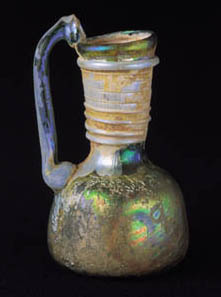|
Iridescence
The enamel-like shell covering the vessels is
very brittle and susceptible to flaking. As the outer shell breaks
away, it exposes the flimsier individual silica films beneath and
disrupts their integrity: the coatings become patchy and variable in
thickness. To the human eye, the patches scatter light in such a
way as to produce a brilliant peacock feather look that we call
iridescence.
The environment in which the glass vessels are
stored today must remain moist or else the layers of silica gel
will dry out and crumble. All the weathering layers are fragile
and tend to break away if the glass vessel is handled too often.
During the 1880's, Louis Comfort Tiffany created
an iridescent glass which he called favrile glass. He achieved the
iridescent appearance, however, by addition of metal oxides and variation
of furnace temperature.
|
|

Juglet with remnants
of initial weathering
Late 4th century A.D.
Ht., 7.1 cm
|

